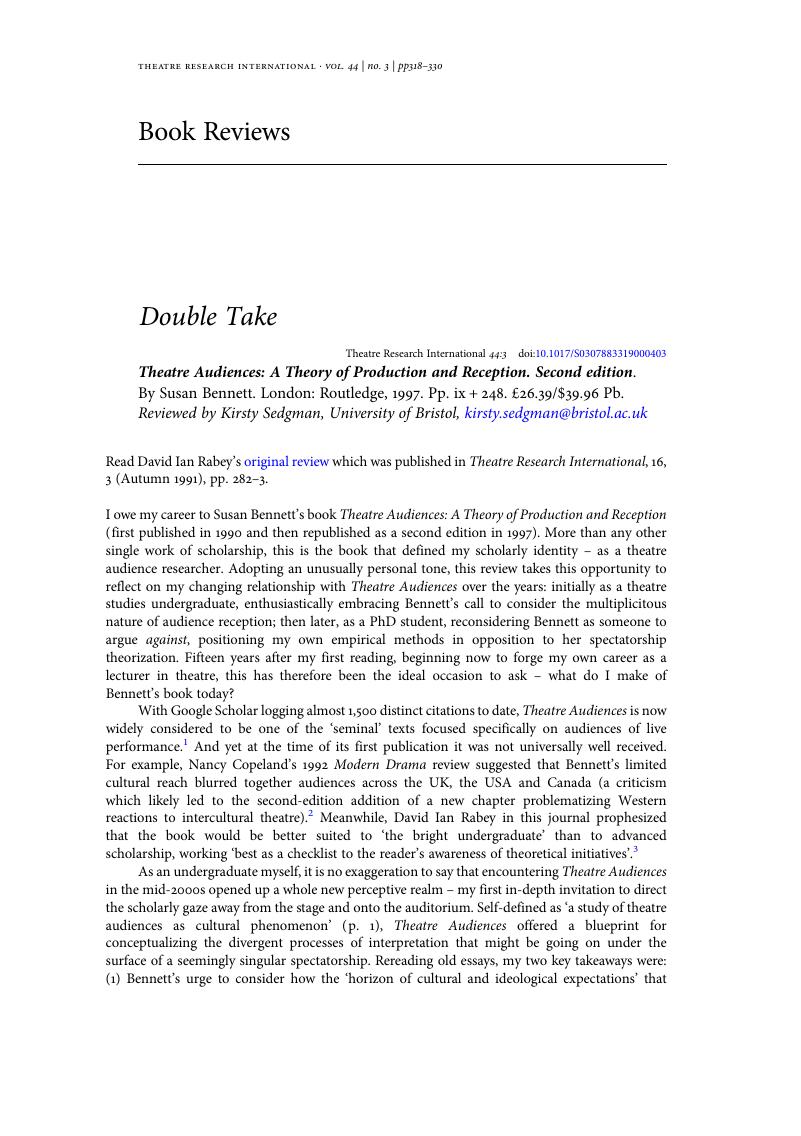No CrossRef data available.
Article contents
Theatre Audiences: A Theory of Production and Reception. Second edition. By Susan Bennett. London: Routledge, 1997. Pp. ix + 248. £26.39/$39.96 Pb.
Review products
Published online by Cambridge University Press: 13 November 2019
Abstract

- Type
- Double Take
- Information
- Copyright
- Copyright © International Federation for Theatre Research 2019
References
NOTES
1 Texts that use this adjective include MacDonald, Laura, Everett, William A. and Bouko's, Catherine ‘On Spectatorship’, Contemporary Theatre Review, 25, 1 (2015), pp. 143–5Google Scholar; Heim's, Caroline Audience as Performer (London: Routledge, 2015)CrossRefGoogle Scholar; Hadley's, Bree ‘Participation, Politics and Provocations’, Participations, 12, 1 (2015), pp. 154–74Google Scholar.
2 Copeland, Nancy, ‘Theatre Audiences by Susan Bennett (review)’, Modern Drama, 35, 2 (1992), pp. 350–1Google Scholar.
3 Rabey, David Ian, ‘Theatre Audiences. By Susan Bennett’, Theatre Research International, 16, 3 (1991), pp. 282–3CrossRefGoogle Scholar, here p. 282.
4 There is not the capacity here to delve into an analysis of the academic field of audience studies, a niche yet verdant corner of cultural studies and media and mass-communications research, which since the 1980s has worked collectively to capture how audiences make meaning from their cultural practices. For a summary of disciplinary shifts and key debates see Kirsty Sedgman, ‘On Rigour in Theatre Audience Research’, Contemporary Theatre Review (forthcoming).
5 For example, in one breath Bennett takes German literary scholar Wolfgang Iser to task for his assumption that the gaps in Waiting for Godot confront audiences with the futility of their own desire for narrative closure, suggesting instead, ‘It might well be argued, however, that gaps in fact merely provoke the reader into accepting gaps’, whilst in another claiming that ‘Beckett's theatre captures audience attention, not the least by the brilliance with which he exploits the mechanics of theatre’. Bennett, p. 47.
6 Bennett's engagement with empirical research is confined to one small section midway through the book, focusing on a swift gallop through Baumol and Bowen's 1966 and Throsby and Withers's 1979 quantitative studies of audience composition, along with Frank Coppetiers’ qualitative 1981 ‘Performance and Perception’ and Anne-Marie Gourdon's 1982 Théâtre, Public, Perception – work which gets dismissed fairly hastily for its ‘limited value’ and generally ‘unsurprising’ findings. Bennett, p.89.
7 Ibid., p. 4.
8 Freshwater, Helen, Theatre & Audience (London: Macmillan, 2009), pp. 28–9CrossRefGoogle Scholar.
9 Neither is this an early lacuna: in her follow-up article, ‘Theatre Audiences, Redux’, written in 2006, Bennett further reaffirms her belief that there is no need to ‘add to theatre studies a social-sciences subfield that specializes in data collection and analysis’. Bennett, Susan, ‘Theatre Audiences, Redux’, Theatre Survey, 47, 2 (2006), pp. 225–30CrossRefGoogle Scholar, here p. 227.
10 Reinelt, Janelle, ‘What UK Spectators Know: Understanding How We Come to Value Theatre’, Theatre Journal, 66, 3 (2014), pp. 337–61CrossRefGoogle Scholar, here p. 339.
11 Sedgman, Kirsty, ‘Audience Experience in an Anti-expert Age’, Theatre Research International 42, 3 (2017), pp. 307–22CrossRefGoogle Scholar.
12 Routledge, ‘Author Guidelines: Theatre & Performance Series in Audience Research’, https://drive.google.com/file/d/1wuoKCpm1YxGHB-4LznM2-sO7A0hpSTsv/view, accessed 21 July 2019.




